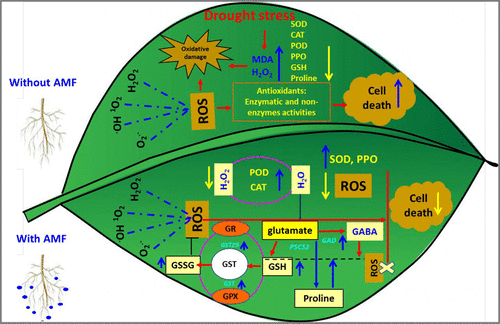当前位置:
X-MOL 学术
›
J. Agric. Food Chem.
›
论文详情
Our official English website, www.x-mol.net, welcomes your
feedback! (Note: you will need to create a separate account there.)
Mycorrhizal Colonization Enhanced Sorghum bicolor Tolerance under Soil Water Deficit Conditions by Coordination of Proline and Reduced Glutathione (GSH)
Journal of Agricultural and Food Chemistry ( IF 5.7 ) Pub Date : 2022-04-04 , DOI: 10.1021/acs.jafc.1c07184 Kuberan Thangaraj 1 , Jianjie Li 2 , Huiling Mei 2 , Shunkai Hu 1 , Rui Han 1 , Zhen Zhao 1 , Xuan Chen 1 , Xinghui Li 1 , Dharmaraj Kamatchi Reddiar 3
Journal of Agricultural and Food Chemistry ( IF 5.7 ) Pub Date : 2022-04-04 , DOI: 10.1021/acs.jafc.1c07184 Kuberan Thangaraj 1 , Jianjie Li 2 , Huiling Mei 2 , Shunkai Hu 1 , Rui Han 1 , Zhen Zhao 1 , Xuan Chen 1 , Xinghui Li 1 , Dharmaraj Kamatchi Reddiar 3
Affiliation

|
Drought stress is an important limiting factor in crop production. Arbuscular mycorrhizal fungi (AMF) enhance plant drought tolerance through antioxidant activities. However, the coordination of nonenzymatic antioxidants against drought remains unclear. Here, we investigated the AMF symbiosis in drought tolerance of Sorghum bicolor by increasing proline and reducing glutathione (GSH). Glomus mosseae inoculation increased grain yield, biochemical content, and bioactivities of millets. Under drought conditions, seedlings inoculated with G. mosseae had higher SOD, POD, CAT, PPO, proline, and GSH activities compared to noninoculated controls. Meanwhile, a lower accumulation of MDA and H2O2 was observed in the G. mosseae seedlings. Furthermore, genes attributed to nonenzymatic antioxidants, such as GST29, P5CS2, FD3, GST, and GAD, were significantly up-regulated by G. mosseae under drought conditions. In conclusion, G. mosseae inoculation enhanced the drought tolerance of S. bicolor by improving reactive oxygen species (ROS) scavengers, including proline and GSH, that regulate ROS production and prevent oxidative damage.
中文翻译:

通过脯氨酸和还原型谷胱甘肽(GSH)的协调,菌根定植增强土壤水分亏缺条件下高粱双色耐受性
干旱胁迫是作物生产的重要限制因素。丛枝菌根真菌 (AMF) 通过抗氧化活性增强植物的耐旱性。然而,非酶抗氧化剂对干旱的协调作用仍不清楚。在这里,我们通过增加脯氨酸和减少谷胱甘肽 (GSH)研究了 AMF 在双色高粱耐旱性中的共生关系。接种Glomus mosseae提高了小米的产量、生化含量和生物活性。在干旱条件下,与未接种的对照相比,接种G. mosseae的幼苗具有更高的 SOD、POD、CAT、PPO、脯氨酸和 GSH 活性。同时,MDA和H 2 O 2的积累量较低。G. mosseae幼苗。此外,归因于非酶抗氧化剂的基因,如GST29、P5CS2、FD3、GST和GAD ,在干旱条件下被G. mosseae显着上调。总之,G. mosseae接种通过改善活性氧 (ROS) 清除剂(包括脯氨酸和 GSH)来增强S. bicolor的耐旱性,这些清除剂可调节 ROS 的产生并防止氧化损伤。
更新日期:2022-04-04
中文翻译:

通过脯氨酸和还原型谷胱甘肽(GSH)的协调,菌根定植增强土壤水分亏缺条件下高粱双色耐受性
干旱胁迫是作物生产的重要限制因素。丛枝菌根真菌 (AMF) 通过抗氧化活性增强植物的耐旱性。然而,非酶抗氧化剂对干旱的协调作用仍不清楚。在这里,我们通过增加脯氨酸和减少谷胱甘肽 (GSH)研究了 AMF 在双色高粱耐旱性中的共生关系。接种Glomus mosseae提高了小米的产量、生化含量和生物活性。在干旱条件下,与未接种的对照相比,接种G. mosseae的幼苗具有更高的 SOD、POD、CAT、PPO、脯氨酸和 GSH 活性。同时,MDA和H 2 O 2的积累量较低。G. mosseae幼苗。此外,归因于非酶抗氧化剂的基因,如GST29、P5CS2、FD3、GST和GAD ,在干旱条件下被G. mosseae显着上调。总之,G. mosseae接种通过改善活性氧 (ROS) 清除剂(包括脯氨酸和 GSH)来增强S. bicolor的耐旱性,这些清除剂可调节 ROS 的产生并防止氧化损伤。


















































 京公网安备 11010802027423号
京公网安备 11010802027423号